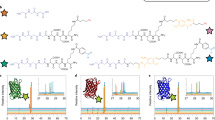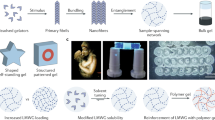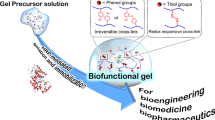Abstract
Click chemistry provides extremely selective and orthogonal reactions that proceed with high efficiency and under a variety of mild conditions, the most common example being the copper(I)-catalysed reaction of azides with alkynes1,2. While the versatility of click reactions has been broadly exploited3,4,5, a major limitation is the intrinsic toxicity of the synthetic schemes and the inability to translate these approaches into biological applications. This manuscript introduces a robust synthetic strategy where macromolecular precursors react through a copper-free click chemistry6, allowing for the direct encapsulation of cells within click hydrogels for the first time. Subsequently, an orthogonal thiol–ene photocoupling chemistry is introduced that enables patterning of biological functionalities within the gel in real time and with micrometre-scale resolution. This material system enables us to tailor independently the biophysical and biochemical properties of the cell culture microenvironments in situ. This synthetic approach uniquely allows for the direct fabrication of biologically functionalized gels with ideal structures that can be photopatterned, and all in the presence of cells.
This is a preview of subscription content, access via your institution
Access options
Subscribe to this journal
Receive 12 print issues and online access
$259.00 per year
only $21.58 per issue
Buy this article
- Purchase on Springer Link
- Instant access to full article PDF
Prices may be subject to local taxes which are calculated during checkout




Similar content being viewed by others
References
Kolb, H. C., Finn, M. G. & Sharpless, K. B. Click chemistry: Diverse chemical function from a few good reactions. Angew. Chem. Int. Ed. 40, 2004–2021 (2001).
Huisgen, R. 1.3-Dipolare Cycloadditionen—Ruckschau und Ausblick. Angew. Chem. Int. Ed. 75, 604–637 (1963).
Moses, J. E. & Moorhouse, A. D. The growing applications of click chemistry. Chem. Soc. Rev. 36, 1249–1262 (2007).
Kolb, H. C. & Sharpless, K. B. The growing impact of click chemistry on drug discovery. Drug Discov. Today 8, 1128–1137 (2003).
Hawker, C. J. & Wooley, K. L. The convergence of synthetic organic and polymer chemistries. Science 309, 1200–1205 (2005).
Baskin, J. M. et al. Copper-free click chemistry for dynamic in vivo imaging. Proc. Natl Acad. Sci. USA 104, 16793–16797 (2007).
Srinivasan, R., Li, J., Ng, S. L., Kalesh, K. A. & Yao, S. Q. Methods of using click chemistry in the discovery of enzyme inhibitors. Nature Protocols 2, 2655–2664 (2007).
Evans, M. J., Saghatelian, A., Sorensen, E. J. & Cravatt, B. F. Target discovery in small-molecule cell-based screens by in situ proteome reactivity profiling. Nature Biotech. 23, 1303–1307 (2005).
Franc, G. & Kakkar, A. Dendrimer design using Cu–I-catalyzed alkyne-azide ‘click-chemistry’. Chem. Commun. 5267–5276 (2008).
Malkoch, M. et al. Synthesis of well-defined hydrogel networks using click chemistry. Chem. Commun. 2774–2776 (2006).
Polizzotti, B. D., Fairbanks, B. D. & Anseth, K. S. Three-dimensional biochemical patterning of click-based composite hydrogels via thiolene photopolymerization. Biomacromolecules 9, 1084–1087 (2008).
Tornoe, C. W., Christensen, C. & Meldal, M. Peptidotriazoles on solid phase: [1,2,3]-triazoles by regiospecific copper(I)-catalyzed 1,3-dipolar cycloadditions of terminal alkynes to azides. J. Org. Chem. 67, 3057–3064 (2002).
Franke, R., Doll, C. & Eichler, J. Peptide ligation through click chemistry for the generation of assembled and scaffolded peptides. Tetrahedron Lett. 46, 4479–4482 (2005).
Prescher, J. A. & Bertozzi, C. R. Chemistry in living systems. Nature Chem. Biol. 1, 13–21 (2005).
Chen, J. K. Fish ’n clicks. Nature Chem. Biol. 4, 391–392 (2008).
Agard, N. J., Prescher, J. A. & Bertozzi, C. R. A strain-promoted [3+2] azide–alkyne cycloaddition for covalent modification of biomolecules in living systems. J. Am. Chem. Soc. 126, 15046–15047 (2004).
Laughlin, S. T., Baskin, J. M., Amacher, S. L. & Bertozzi, C. R. In vivo imaging of membrane-associated glycans in developing zebrafish. Science 320, 664–667 (2008).
Dondoni, A. The emergence of thiol–ene coupling as a click process for materials and bioorganic chemistry. Angew. Chem. Int. Ed. 47, 8995–8997 (2008).
Hoyle, C. E., Lee, T. Y. & Roper, T. Thiol–enes: Chemistry of the past with promise for the future. J. Polym. Sci. A 42, 5301–5338 (2004).
Khire, V. S., Benoit, D. S. W., Anseth, K. S. & Bowman, C. N. Ultrathin gradient films using thiol–ene polymerizations. J. Polym. Sci. A 44, 7027–7039 (2006).
Killops, K. L., Campos, L. M. & Hawker, C. J. Robust, efficient, and orthogonal synthesis of dendrimers via thiol–ene ‘click’ chemistry. J. Am. Chem. Soc. 130, 5062–5064 (2008).
Langer, R. & Vacanti, J. P. Tissue engineering. Science 260, 920–926 (1993).
Cushing, M. C. & Anseth, K. S. Hydrogel cell cultures. Science 316, 1133–1134 (2007).
Anseth, K. S. A biologist looks to ‘click chemistry’ for better three-dimensional tissue models. Nature 453, 5 (2008).
Codelli, J. A., Baskin, J. M., Agard, N. J. & Bertozzi, C. R. Second-generation difluorinated cyclooctynes for copper-free click chemistry. J. Am. Chem. Soc. 130, 11486–11493 (2008).
Nagase, H. & Fields, G. B. Human matrix metalloproteinase specificity studies using collagen sequence-based synthetic peptides. Biopolymers 40, 399–416 (1996).
Lutolf, M. P. et al. Synthetic matrix metalloproteinase-sensitive hydrogels for the conduction of tissue regeneration: Engineering cell-invasion characteristics. Proc. Natl Acad. Sci. USA 100, 5413–5418 (2003).
Lutolf, M. P. & Hubbell, J. A. Synthetic biomaterials as instructive extracellular microenvironments for morphogenesis in tissue engineering. Nature Biotech. 23, 47–55 (2005).
Kunz, H. & Unverzagt, C. The allyloxycarbonyl (aloc) moiety—conversion of an unsuitable into a valuable amino protecting group for peptide-synthesis. Angew. Chem. Int. Ed. 23, 436–437 (1984).
Lee, T. Y., Smith, Z., Reddy, S. K., Cramer, N. B. & Bowman, C. N. Thiol–allyl ether–methacrylate ternary systems. Polymerization mechanism. Macromolecules 40, 1466–1472 (2007).
Mather, B. D., Viswanathan, K., Miller, K. M. & Long, T. E. Michael addition reactions in macromolecular design for emerging technologies. Prog. Polym. Sci. 31, 487–531 (2006).
Cramer, N. B., Reddy, S. K., O’Brien, A. K. & Bowman, C. N. Thiol–ene photopolymerization mechanism and rate limiting step changes for various vinyl functional group chemistries. Macromolecules 36, 7964–7969 (2003).
Ruoslahti, E. & Pierschbacher, M. D. New perspectives in cell-adhesion—RGD and integrins. Science 238, 491–497 (1987).
Burdick, J. A. & Anseth, K. S. Photoencapsulation of osteoblasts in injectable RGD-modified PEG hydrogels for bone tissue engineering. Biomaterials 23, 4315–4323 (2002).
Hahn, M. S., Miller, J. S. & West, J. L. Three-dimensional biochemical and biomechanical patterning of hydrogels for guiding cell behaviour. Adv. Mater. 18, 2679–2684 (2006).
Lee, S. H., Moon, J. J. & West, J. L. Three-dimensional micropatterning of bioactive hydrogels via two-photon laser scanning photolithography for guided 3D cell migration. Biomaterials 29, 2962–2968 (2008).
Luo, Y. & Shoichet, M. S. A photolabile hydrogel for guided three-dimensional cell growth and migration. Nature Mater. 3, 249–253 (2004).
Acknowledgements
The authors would like to thank C. Bertozzi and J. Baskin for their initial donation of DIFO3, R. Shoemaker for his assistance with magic-angle spinning NMR, A. Kloxin and B. Fairbanks for their discussions on photopatterning, A. Aimetti for communication on peptide work and C. Kloxin for his critiques in the preparation of this manuscript. Thanks are also given to HHMI and the Janelia Farm Research Campus for support in the use of their two-photon confocal microscope. Fellowship assistance to C.A.D. was awarded by the US Department of Education’s Graduate Assistantships in Areas of National Need program and the National Institutes of Health (T32 GM-065103).
Author information
Authors and Affiliations
Contributions
B.D.P., C.A.D. and K.S.A. developed the material concept, C.A.D., B.D.P. and K.S.A. designed the experiments, C.A.D. carried out the experiments, and C.A.D. and K.S.A. composed the manuscript.
Corresponding author
Supplementary information
Supplementary Information
Supplementary Information (PDF 1006 kb)
Rights and permissions
About this article
Cite this article
DeForest, C., Polizzotti, B. & Anseth, K. Sequential click reactions for synthesizing and patterning three-dimensional cell microenvironments. Nature Mater 8, 659–664 (2009). https://doi.org/10.1038/nmat2473
Received:
Accepted:
Published:
Issue Date:
DOI: https://doi.org/10.1038/nmat2473



